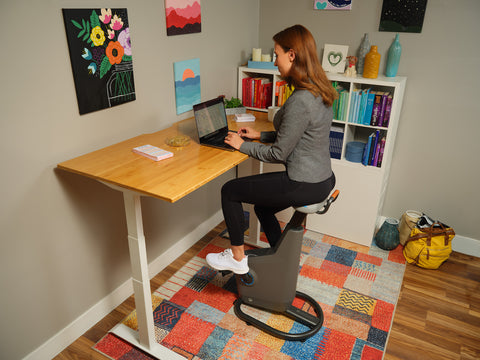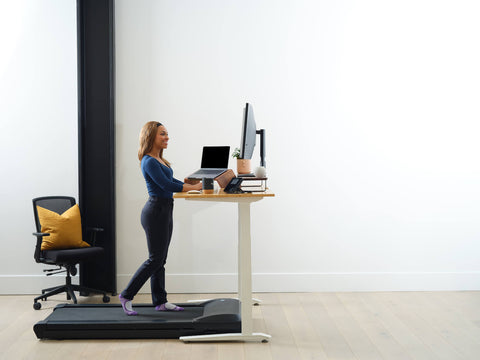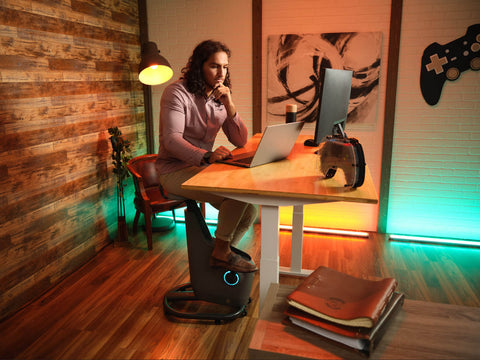With all the different options out there, selecting the right standing desk pad/mat to accommodate your needs can seem overwhelming. Pads can vary in shape, thickness, size, materials, and topography. While it may not seem like it, each is better suited for specific needs.
To start, you will want to determine your needs as well as the environment in which you will be using the mat.
While most standing desk pads on the market will deliver similar ergonomic benefits, you will find that some are more suited to your liking and needs than others. If you are unable to test out a selection of standing mats prior to purchasing, we recommend keeping the mat specifications and qualities listed below in consideration.

What to Consider When Buying Standing Mats:
Size
When first selecting a pad, you will want to first make sure it will fit in the allotted area beneath your desk. The more obvious dimensions to consider are the length and width, but you will also want to keep the thickness in mind. This is because the thickness of the pad will take away from your height-adjustment range on your standing desk. So, you will want to make sure you have the ability to increase the height of your desk factoring in the height of the pad. This will help ensure proper standing desk ergonomics.
Material & Texture
You will find that most pads on the market are made out of similar materials. When buying standing mats, keep in mind the durability, ease of cleaning, and how readily the mat will shift around. Nothing is worse than having to constantly re-adjust an office standing mat as a result of it sliding around on the floor.
Commonly, standing mats are composed of polyurethane foam or a gel. If the material isn’t listed, it’s most likely polyurethane foam. Where the mats begin to vary is with the thickness and surface texture. From a basic grained texture to a fancier cross-hatched pattern, any texture will serve the exact same anti-slip purpose.
In terms of the thickness, this will be based on personal feel. If you want a stiffer mat, choose a less thick one. If you like a mat with little more cushion and give, choose a thicker one. You’ll also find that foam mats tend to be a little stiffer than a gel mat. Just keep in mind that you don’t want the mat to be too squishy which may make you unstable, placing strain on your joints.
In terms of durability, any polyurethane foam standing desk pad will provide lasting durability. Most of the wear and tear will result in how you handle the mat. Wearing heals while standing on the mat is never recommend as it will degrade the integrating. You will also want to avoid rolling the mat for the same reason.
Shape
Most standing desk pads are a simple rectangular or square shape. Made so to reflect the size of the allotted space beneath a standing desk. There are however, some more unique shapes for sale. Again, the shape is more of a personal choice. One doesn’t provide more of a benefit over another. You will just want to make sure the mat you choose has beveled edges so it isn’t a potential tripping hazard.
Topography (Topo Mat)
First, you may be wondering, what is a “topo” standing mat? In this case, topography is used to define increases/decreases in the mat height. Picture a simple topography map, but to a lesser degree. The proposed benefits to having standing mats with topography is both to encourage movement and to allow for angles and edges to stretch your muscles with. Whereas a simple, flat mat is used to alleviate pressure and aches in your muscles and joints from standing still for prolonged periods of time. While topo standing mats tend to be a little pricier, in terms of use with a standing desk, they are worth the increased cost.
Additional Standing Options

An available alternative to a standing desk mat is a balance board or standing board. When placed underneath a standing desk, a balance board serves a similar purpose. A balance board cushions your joints alleviating muscle strain and aches. But unlike a standing mat, a balance board will enhance functional strength and increase coordination, improve balance and stability, reducing back and joint pain, and even help alleviate arthritis in your knees. Like a standing mat, balance boards for standing desks are available in a variety of shapes and sizes, and are constructed of varying materials.
More information on balance board benefits
Standing Desk Best Practices
Outside of the above list of considerations, keep in mind standing desk best practices and proper ergonomic settings. With the addition of your new standing mat or balance board, keep these setup tips in mind:

- Head and neck are level and in-line with the torso.
- Elbows are close to the body and bent between 90 and 120 degrees. The height of your standing desk height should be adjusted accordingly.
- Top of the monitor is at or just below eye level so you don't need to tilt the head up or bend the neck down to see the monitor.
- Wrists and hands are straight, in-line, and roughly parallel to the floor.
- Shoulders should be relaxed.
Following these standing desk best practices will help alleviate any fatigue and/or muscle strain brought on by standing. You may also want to consider alternating between sitting and standing throughout your workday if you desk allows for it.









